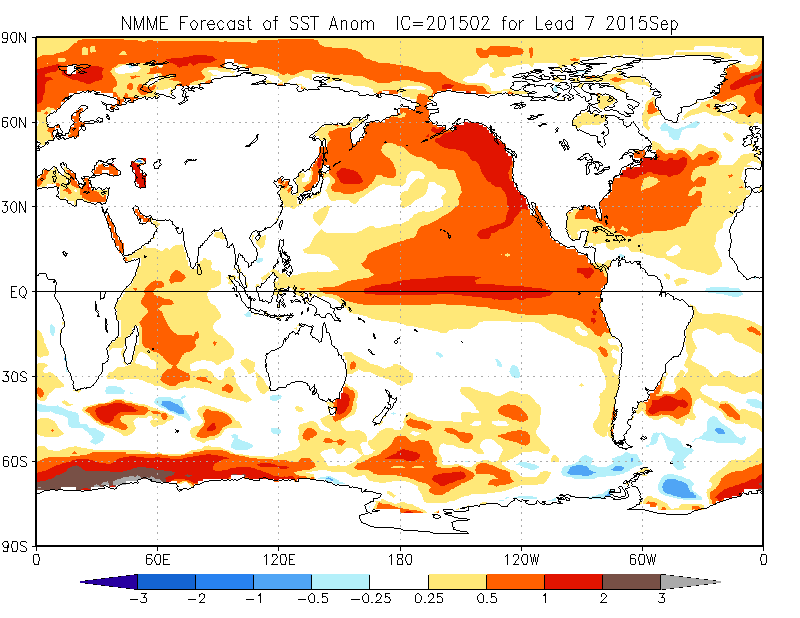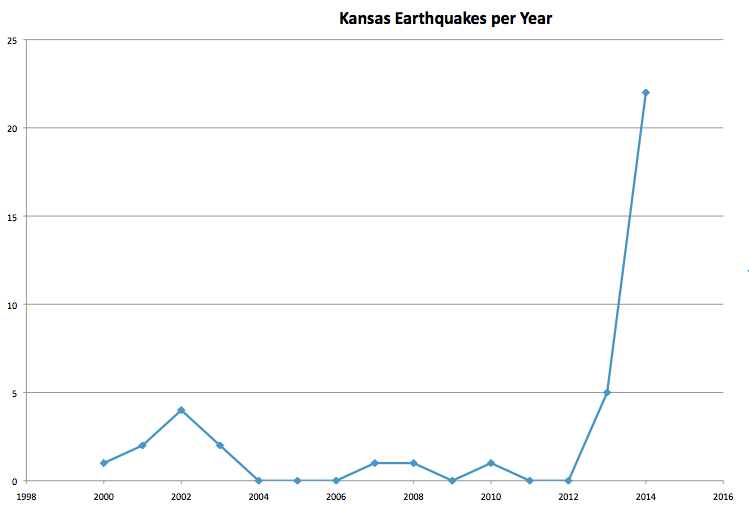Spotted in my backyard the other day:
Wednesday, April 29, 2015
Friday, April 24, 2015
Most Awkward Climate #LeaveItThere Ever?
I'm used to stories about the impacts of climate change that leave out the cause altogether. But a recent CNN story on a huge blob of overheated water off America's Pacific Coast set a new standard for brushing past climate science while still giving it the cold shoulder.
First, Slate's Eric Holthaus explains the blob's connection to global warming:
First, Slate's Eric Holthaus explains the blob's connection to global warming:
Besides El Niño, a more worrying, longer-term trend is also taking shape. The Pacific Decadal Oscillation (PDO) is a decades-long periodic warming of the Pacific Ocean that tends to favor bursts of accelerated global warming. As I wrote last October, the Pacific appears to be in the midst of a shift into a new warm phase that could last 20 years or so.CNN's story never mentions global warming - in fact, just when it feels like they're about to, the story abruptly ends. "But other scientists are saying it's more than that," says Jennifer Gray - then it cuts to black. No explanation, CNN just leaves it there.
The PDO—or, “the blob” as it’s been referred to recently—is starting to freak out some scientists. There are emerging signs of a major shift in the Pacific Ocean’s food chain, including a dearth of plankton, tropical fish sightings near Alaska, and thousands of starving sea lion pups stranded on the California coast. As Earth’s largest ocean, what happens in the Pacific affects the weather virtually planet-wide, and that means an “imminent” jump in global warming may have already begun—spurred on by the PDO.
The PDO has skyrocketed to record-high monthly levels over the past four months. In fact, there have only been four other similarly warm four-month bursts of the PDO in the last 115 years (in 1940, 1941, 1993, and 1997). A quick look at the historical record (for both 15 years prior to and 15 years after the bursts) shows that global temperatures rose at twice the rate of the 20th century average immediately after these bursts.
Combined with the overall long-term warming trend from climate change, the emergence of the PDO warm phase means the current state of the world’s oceans has little precedent.
Posted by
TheGreenMiles
at
Friday, April 24, 2015
Monday, April 20, 2015
"The World is Looking to Us to Lead": President Obama's Weekly Address on Climate Change
Here's the transcript and here's a link to tell Congress you support President Obama's plan to act on climate.
Posted by
TheGreenMiles
at
Monday, April 20, 2015
Wednesday, April 15, 2015
America's Worst-Named Wildlife: Fisher Cats
 It’s always driven me crazy that fisher cats don't catch fish and aren't cats. If I had $1 billion I’d start a campaign to switch the casual reference to one of their Native American names:
It’s always driven me crazy that fisher cats don't catch fish and aren't cats. If I had $1 billion I’d start a campaign to switch the casual reference to one of their Native American names:
The fisher (Martes pennanti) is a small carnivorous mammal native to North America. It is a member of the mustelid family, commonly referred to as the weasel family. The fisher is closely related to but larger than the American Marten (Martes americana). The fisher is a forest-dwelling creature whose range covers much of the boreal forest in Canada to the northern United States. Names derived from aboriginal languages include pekan, pequam, and wejack. It is also sometimes referred to as a fisher cat, although it is not a feline.Wejack! Sounds like a ‘70s movie cop who doesn’t play by the rules. Let's go with that. Who's with me?
As bonus evidence of fisher's awesomeness, I present this random high school film project I found on YouTube:
Posted by
TheGreenMiles
at
Wednesday, April 15, 2015
Wednesday, April 8, 2015
Everyone Hates Coal. Pandering To It Is Stupid Politics.
Political reporters paint investments in clean energy as a pander to a narrow segment of the Democratic base, while pledges to continue investment in coal are framed as smart plays to shoring up the moderate middle. And of course you have to support corn ethanol or you'll lose the entire center of the country!
But take a look at this new poll of homeowners by Zogby Analytics for Clean Edge and Solar City:
It's solar and wind that are broadly popular, while coal and biofuels have only fringe support - and keep in mind this question allowed people to name their top three.
Meanwhile, for all the talk of the popularity of fracked gas, it finished a distant third to clean energy.
But take a look at this new poll of homeowners by Zogby Analytics for Clean Edge and Solar City:
It's solar and wind that are broadly popular, while coal and biofuels have only fringe support - and keep in mind this question allowed people to name their top three.
Meanwhile, for all the talk of the popularity of fracked gas, it finished a distant third to clean energy.
Posted by
TheGreenMiles
at
Wednesday, April 08, 2015
Warmth Records Continued to Fall Out West in March 2015
These cities had their hottest March on record:
It was also the 2nd-warmest March in Billings, Montana and both Phoenix and Tucson, Arizona.
And not one of the articles mentioned climate change.
It was also the 2nd-warmest March in Billings, Montana and both Phoenix and Tucson, Arizona.
And not one of the articles mentioned climate change.
Posted by
TheGreenMiles
at
Wednesday, April 08, 2015
Sunday, April 5, 2015
Comcast's New "Power Save" X1 Boxes Still Waste Tons of Energy
Energy-wasting cable boxes cost families an extra $100 a year each, so when Comcast sent me a new X1 box, I was eager to learn more about its new "Power Save" feature.
The first disappointment: "Power Save" arrived turned off. I had to go into the power settings to tell it to go to Power Save after a certain number of hours. How many customers will ever do that? 10 percent?
The first disappointment: "Power Save" arrived turned off. I had to go into the power settings to tell it to go to Power Save after a certain number of hours. How many customers will ever do that? 10 percent?
But what's even more confusing is figuring out what Power Save actually does. From Comcast's Power Save FAQ:
Your energy saving depends on the specific X1 set-top box type (DVR or non-DVR), how much time the device is in Power Save mode and what power-saving activities are going on behind the scenes (such as scheduled recordings). Because of these variables, we can't say exactly how much energy your set-top box saves in Power Save mode, but to maximize your energy savings, you should always put your set-top box in Power Save mode as soon as you are done watching TV.
Notice how Comcast carefully avoids making factual claims about how much energy is actually saved - if any.
OK, time to put it to the test. My old Comcast box registered 86 degrees in a 75 degree room. How does the new X1 box do when in use?
82 degrees in a 67 degree room. Not much better. And after it had been in Power Save mode all night (with no DVR recordings or any reason to be active):
Even though the room was down to 62 degrees and it had been in "Power Save" mode for several hours, the Comcast box still registered 78 degrees, not much different than when in use.
Comcast's "new" boxes don't seem any better than the old ones at sucking tons of vampire power, turning lots of your money into waste heat.
UPDATE 8/6/15: One other thing that's bugged me after several months of use. To save money & energy, I have the box and my TV plugged into a power strip that I can turn off. But the Comcast X1 box takes several minutes to start back up - even longer than my computer. And that long wait isn't because of fantastic performance - the box is painfully slow to respond to the remote and move between menu screens.
The bottom line is that while this box delivers flashier graphics, in terms wasting energy and slow performance, it's no better than the old boxes it replaced.
UPDATE 8/6/15: One other thing that's bugged me after several months of use. To save money & energy, I have the box and my TV plugged into a power strip that I can turn off. But the Comcast X1 box takes several minutes to start back up - even longer than my computer. And that long wait isn't because of fantastic performance - the box is painfully slow to respond to the remote and move between menu screens.
The bottom line is that while this box delivers flashier graphics, in terms wasting energy and slow performance, it's no better than the old boxes it replaced.
Posted by
TheGreenMiles
at
Sunday, April 05, 2015
Thursday, April 2, 2015
Kansas Finally Admits It Has a Fracking Earthquake Problem
How deep in Big Oil's pocket are Oklahoma legislators when even Sam Brownback's Conservative Utopia of Kansas (A Subsidiary of Koch Industries) will admit it has a fracking earthquake problem, but Oklahoma is still in denial?
As E&E's Mike Soraghan reports, Kansas is facing up to its frackquake problem and taking action:
UPDATE 4/22/15: Oklahoma has ended its frackquake denial.
As E&E's Mike Soraghan reports, Kansas is facing up to its frackquake problem and taking action:
Regulators in Kansas have imposed sharp restrictions on oil and gas activity in two southern counties in response to increased earthquakes in the area.Meanwhile, Oklahoma's denial sounds a lot like Florida's state-ordered climate science denial. We can't talk about the cause because that would be a distraction from trying to deal with the effects, or something!
The Kansas Corporation Commission (KCC) cited an "immediate danger" to public safety as the reason for limiting the pressure that can be used to inject wastewater into disposal wells and the volumes that can be injected.
The Oklahoma commission has also avoided explicitly linking earthquakes to disposal wells, saying getting embroiled in such a debate could bog down its response. But Kansas officials made a direct correlation.This is an issue that states far from America's new FrackQuake Alley need to face up to. Here in Massachusetts, new fracked gas pipelines are being sold as the solution to all our problems. But in addition to the question of whether we even need new enormously expensive pipelines, do we really want to be supporting this kind of destructive drilling that also threatens public health in fracked communities?
"The increased number of recorded earthquakes in Kansas coincides with an increase in the number of injection wells and the amounts of injected saltwater in Harper and Sumner counties," the order states.
Kansas had 127 earthquakes last year, according to the commission order, and more than 50 this year by mid-March. From 1981 to 2010, Kansas had 31 quakes.
UPDATE 4/22/15: Oklahoma has ended its frackquake denial.
Posted by
TheGreenMiles
at
Thursday, April 02, 2015
Subscribe to:
Comments (Atom)





